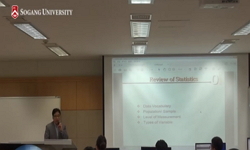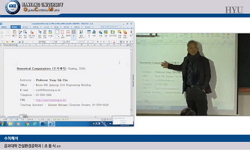해양의 수온 관측 자료는 결측 구간이 빈번하게 발생하기 때문에 관측 자료의 전처리 과정에서 결측 구간의 보정이 필수 적이다. 특히, 현장 시료의 채집과 분석에 기반한 관측소의 경우 주...
http://chineseinput.net/에서 pinyin(병음)방식으로 중국어를 변환할 수 있습니다.
변환된 중국어를 복사하여 사용하시면 됩니다.
- 中文 을 입력하시려면 zhongwen을 입력하시고 space를누르시면됩니다.
- 北京 을 입력하시려면 beijing을 입력하시고 space를 누르시면 됩니다.

연안 정지 관측 시계열 데이터 결측치 보정에 관한 실증연구: 주문진 관측소 중심으로 = An Empirical Study on the Correction of Missing Data in Coastal Stationary Observation Time Series Data: Focusing on Jumunjin Observatory
한글로보기부가정보
국문 초록 (Abstract)
해양의 수온 관측 자료는 결측 구간이 빈번하게 발생하기 때문에 관측 자료의 전처리 과정에서 결측 구간의 보정이 필수 적이다. 특히, 현장 시료의 채집과 분석에 기반한 관측소의 경우 주말 및 기상악화 시 반복적이고 주기적으로 결측이 발생하는 구조를 가진다. 본 연구에서는 연안정지 관측 데이터 중 수온의 결측치 보정을 위한 최적화된 방법을 모색하고자 통계적 방법인 다중 대치법(Multiple Imputation, MI), 회귀모델인 자기회귀 누적 이동평균(Auto-Regressive Integrated Moving Average, ARIMA) 모델 및 인공신경망 방법인 장단기 메모리(Long Short Term Memory, LSTM) 모델을 사용하였다. 주문진 관측소의 수온 데이터 중 대부분의 결측일은 주말이었다. 모델의 구현은 5일(평일)의 수온 자료를 이용하여 2일(주말)의 수온을 보정하는 방법을 사용하였다. 평균 제곱근 편차(Root Mean Square Error, RMSE)와 평균 절대 오차(Mean Absolute Error, MAE)를 사용하여 모델을 평가하였으며, 각각의 모델을 예측값과 실측값의 잔차를 이용하여 비교 분석하였다. 분석결과 장단기 메모리 모델이 다중 대치법 및 자기회귀 누적 이동평균 모델에 비해 상대적으로 좋은 성능을 보이는 것으로 확인되었다.
다국어 초록 (Multilingual Abstract)
The sea surface temperature (SST) is an important physical property that describes ocean characteristics. However, SST monitoring in harsh marine environments has a discontinuity problem in field observation using a research vessel. Therefore, correct...
The sea surface temperature (SST) is an important physical property that describes ocean characteristics. However, SST monitoring in harsh marine environments has a discontinuity problem in field observation using a research vessel. Therefore, correcting the missing data is essential in the preprocessing of the observation data because the missing data frequently occurs in the sea water temperature observation system. Especially, observation stations based on the collection and analysis of field samples repeatedly and periodically generate missing data during weekends and bad weather. In this study, a statistical method (Multiple Imputation, MI), a regression model (Auto-Regressive Integrated Moving Average, ARIMA), and an artificial neural network method (Long Short Term Memory, LSTM) were tested to find an optimized method for correcting the missing SST data among coastal stationary observation data. Most of the missing SST data at the Jumunjin observatory were from weekends. The models were implemented by correcting the SST for 2 days (weekends) based on SST data for 5 days (weekdays). Models were evaluated using Root Mean Square Error (RMSE) and Mean Absolute Error (MAE), and each model was compared using the residuals between predicted and measured values. Our study indicates that the LSTM model shows relatively better performance compared to MI and ARIMA.
동일학술지(권/호) 다른 논문
-
CNN과 GRU 모델을 활용한 음주상태 판별시스템 설계 및 구현
- 사단법인 한국융합기술연구학회
- 윤성건
- 2023
- KCI등재
-
실시간 스트림 데이터를 위한 새로운 익명화 알고리즘 제안
- 사단법인 한국융합기술연구학회
- 홍성현
- 2023
- KCI등재
-
- 사단법인 한국융합기술연구학회
- 박성한
- 2023
- KCI등재
-
연관규칙을 활용한 KT/A-1 항공기 수리부속 재고 확보 방안
- 사단법인 한국융합기술연구학회
- 김창익
- 2023
- KCI등재




 KCI
KCI






